Contents
To download the below and all other Useful Books and calculations Excel sheets please click here
To download the below and all other Useful Books and calculations Excel sheets please click here
Rotating kiln tyres: lubricating between the tyre and shell
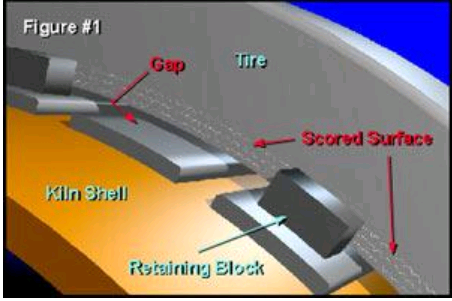
Walter Gebhart, Phillips Kiln Services, USA discusses the philosophy of lubricating between the tyre and kiln shell.
(Reprinted from World Cement, December )
Introduction
To lubricate or not to lubricate? The area under discussion is the mating surface between the bore of a migrating kiln tyre and the shell or shell bars that the tyre sits on. This issue has been controversial for some years now. To be perfectly clear, this discussion does not involve the lubrication of the rolling surface of the tyre. This surface which contacts the face of the rollers, should only see dry graphite as a lubricant and is a separate issue. Although lubricating the tyre bore may seem to be a natural requirement of good rotary kiln operation, some experts in the industry advise against it. Their case is presented with the article by Mr. Robert P. Chapman. His arguments are that a “grease” type lubricant attracts dust and other debris which acts as a grinding compound which accelerates wear. Secondly, an
argument is made that a lubricant promotes slippage and creep which then itself causes more wear since wear is presumed to be proportional to creep and slippage. Promotion of these ideas has led to considerable controversy among those who have been faced with deciding whether to apply lubricant or not. If the action between the tyre and the shell it supports was one of pure rolling,
that is the shell rolling within the tyre, then there would be some merit to Chapman’s arguments. This article argues however, that this is clearly not the case and can never be so. The nature of the overwhelming majority of kiln designs dictates this as will be seen. It is believed that statistical or scientific investigation has never been done on this subject. However, the author believes that the action and reaction between the tyre bore and its supporting elements, be that the shell or intermediate spacer bars, is only a variation of combined rolling and sliding action between surfaces of similar metals. The common knowledge associated with rolling and sliding is applied, and the special circumstances imposed by a kiln tyre are discussed. The following anecdotal incidents and personal experiences though not proof in themselves, help to illustrate the issue.
Case Study 1
In the first case study, pier no. 2 (from the hot end) of a 4 pier cement kiln had to have the shell
under the riding ring and the riding ring replaced. The kiln had been in operation for
approximately ten years and the gap between the shell and the tyre had grown to about 2.5 in. This was an intolerable condition and seriously damaged the refractory, considering only a 0.125 in.
gap is considered normal during a kiln’s operation. Once the old components had been removed the damage was fully exposed. The gouges scarfed from both the bore of the tyre and the surface of the pads were remarkable because they were so deep. Some of the shell support pads had grooves so deep they were almost cut in half. The mating surface on the inside of the tyre was in similar condition which, if it were made of soft butter, looked as it is had been systematically subjected to an ice cream scoop. It is believed that no lubrication was ever applied to the mating areas of the tyre and its support elements.
Case Study 2
In the second example, pier No. 2 (from the hot end) of a 4 pier lime kiln had to have the shell
under the riding ring changed out. This kiln had also been in operation for about ten years but the gap, shell to tyre was normal. Improperly proportioned shell plate thickness and/or lack of tapers where the plate thickness changes had caused severe circumferential weld cracking on each side of the tyre. Inability to keep these cracks from re-appearing, resulted in the decision to replace the shell under the tyre with extended heavy plate which would be fully tapered to meet the thinner plate of the existing kiln shell. The tyre would be re-used. Once the tyre was slipped back to allow removal of the damaged shell, its bore was fully visible. The exposed mating surfaces were as remarkable in appearance, for opposite reasons, as those described in the first case study. These surfaces were not only smooth and relatively unmarked but the inside of the tyre had the appearance of being chrome plated. The result was striking and was due to the application of a lubricant. Further investigation showed that the gold coloured ‘grease’ was a commercially available lubricant specifically formulated for kiln tyres. After ten years of operation, the
condition of these surfaces were visibly better than the originally machined surfaces, suggesting the adage, ‘better to lubricate than not to lubricate’, those areas in contact between the kiln tyre and its support elements.
Comparisons
The reason for failure in the first case study could have been lubrication since the author only
observed the mating surfaces at the time of repair. They were dry, rusty and had the general appearance of never having seen any lubricant of any type. The reason for the chronic scarfing of material was naturally the subject of many discussions. Although it was claimed that areas were not lubricated, no one could prove it. Case study 2, however, allows a more concrete conclusion. For the sake of impartiality, one should not conclude that systematic lubrication maintained those parts for ten years or arguably improved them, even though it is an irresistible conclusion. Instead, one can simply say that periodic lubrication with proper materials had in no way contributed to
any premature wear of the mating surfaces simply because there was no wear visible.
What is creep and why is it necessary?
Due to thermal expansion, a typical kiln grows in length by 4-6 in. from dead cold to its operating
condition. Similarly the circumference also increases in size. Because the tyre is much thicker than the kiln shell and somewhat proud of the general body of the kiln, its average temperature rise is less than that of the shell. Thermal expansion, therefore, increases the diameter of the shell by a greater amount than it does the tyre. If this differential expansion is not carefully accommodated the tyre may restrict shell expansion, distort it permanently and the refractory in this area can be crushed, yielding undesirable results. Hence the tyre must be loose on the shell. As the kiln warms to operating conditions, the shell circumference grows to more closely match the tyre. It is desirable for this shell growth to never quite catch up with the tyre. Damage to either shell or refractory is thus avoided. If there was an ideal process wherein the operating temperatures were completely constant, it would be possible to design it in such a way that at operating conditions
the shell just matches, but is not pinched by the tyre. (The splined tyre support designs, although an expensive capital cost, do eliminate this problem. But since they are very few in number, they are not the subject of discussion here.) Such an ideal process would then avoid having to deal with the problems associated with the differential motion of the tyre and the shell. Ideal processes may be theoretically possible but reality dictates that a range of operating temperatures must be accommodated. A residual gap between shell and tyre is therefore a matter of safety.
Some creep is actually desirable
Since there is a difference between the bore diameter of the tyre and the diameter of the surface it
runs on (the tyre to shell ‘gap’), a revolution for the tyre takes proportionately longer than it does for the shell. This is usually relatively small but measurable and is seen as a slow migration of the tyre around the shell. This differential motion is commonly referred to as ‘creep’. Excessive gap is
as much of a problem as no gap. The tyre not only facilitates the rotary motion of the kiln, but is also responsible for maintaining its roundness and consequently the mechanical integrity of refractory. The shell at the points of support would collapse were it not for the girdling effect of the tyre. The shell can be thought of as a bag of water filling the confines of its supporting tyre. The difference in diameters therefore manifests itself near the top and is not distributed as cotangent circles. In other words when the gap becomes large, there is a flattening effect at the top. This continuous change of curvature during rotation, analogous to the flat spot of a car tyre where it contacts the road, can aggravate the mechanical integrity of the refractory to the point of collapse. Good kiln operation therefore requires that the correct tyre to shell fit or gap of which creep is the normal indicator, must be maintained.
Tyre retainers
Since the tyres are loose around the shell they must be retained from shifting along the length of
the shell. This is done in a variety of ways but is usually accomplished by a simple set of blocks welded to the support pads or directly to the shell on either side of the tyre. Kiln tyres will normally sit against the uphill side retaining blocks. The migration of the tyre produces a circumferential sliding action of the tyre against its retainers. The force with which the tyre sits against its retainers depends on a number of factors, mainly roller skew, slope and alignment. Radial sliding between the retainers and the tyre also occurs due to the gap discussed previously. Consequently the scoring marks on the side of the tyres caused by the retaining blocks are a combination of radial and circumferential sliding and look like the pattern shown in Figure 1.
Lubrication
Graphite is most frequently used for this application. Lubricants specifically formulated for this
service are colloids containing graphite as well as molybdenum, copper, aluminium etc. These are solid lubricating materials in a carrier that is designed to flash off at low temperatures. In no way should this carrier be confused with ‘grease’ implying that a ‘high lubricity grease’ is being applied. The carrier quickly dissipates leaving the solids as a non sticky residue which closely adheres to
(at the microscopic level) the surface of the steel components as witnessed in case study 2. These lubricants are far superior to graphite alone but are correspondingly more expensive. Kilns, as has already been indicated, are not ideal machines. The action between the tyre and the support pads and how to measure it is widely understood and aptly described by Chapman. Chapman also astutely points out that due to heat distortion the support surface presented to the tyre is not circular but has localized perturbations. Because this mechanism is not ideal, slippage will occur with or without lubrication. True rolling action can never be assured and at best is a transient condition. Lubrication therefore is not applied to induce slippage but to prevent any local area from galling and hanging up to the point where metal failure occurs. A greater amount of creep may be seen with the use of a lubricant than without, which if it acts to polish the surfaces is infinitely more desirable than creep which is limited because it tears metal as it proceeds .
The real culprit
Whether an attempt should be made to eliminate slippage and hopefully achieve pure rolling
action between tyre and shell is admittedly at the centre of the lubrication controversy. But is that not skirting the real issue? The action between the tyre retainer blocks and the sides of the tyre is always sliding as long as the tyre is not in the undesirable condition of being locked to the shell due to excessive thermal expansion. Debris getting into the mating surface between the tyre and the shell pads has been cited as the origin of galling and creating self-enlarging slugs that plow through the bore zone. Over the average thirty year life of a kiln in operation it is not weld rod stubs nor air borne material that cause most of the problems. The occasional weld rod stub may in some cases be at fault but how often are they present over the years? Only infrequently. Air borne material, usually kiln product, is gritty and will be ground up, especially at the discharge end tyre. But this grinding action crushes the debris which is brittle and friable, consuming it rather than galling the steel. Galling occurs when dry steel slides against dry steel and the surfaces attach
themselves on the microscopic level thereby destroying each other. The mutual destruction of these surfaces causes the steel to ‘ball up’ forming slugs or spitzers. These particles are overwhelmingly created at the sides of the tyre where they contact the retaining blocks. These then can fall between the tyre bore and its mating surface causing further and potentially more severe damage to the shell pads etc. Even where poor alignment conditions do not cause excessive force, the nature of a typical kiln design necessitates that sliding action exists in these areas. Getting a tyre to ‘float’ between its uphill and downhill retaining blocks is every operator’s objective but is commonly not achieved. Some of the forces causing the tyre to sit towards the feed end of the kiln or towards the discharge end of the kiln, the operator simply cannot control. Lubricating here is as essential to preventing undercutting the tyre and consuming the stop blocks as is vigilant control of alignment. With that accomplished, the bore will unavoidably also see lubrication. Lubricating the bore in this context may seem almost secondary. However, few practitioners doing the lubricating will make such subtle distinctions, so lubricating the complete area, short of letting lubricant hit the rolling surfaces, is completely appropriate. Understanding how a kiln is designed, and all kiln manufacturers must cope with the same laws of nature and mechanics of materials, is the first step to understanding the benefits of maintenance procedures such as lubrication. Lubrication does not correct misalignment, alignment does not correct poor operating habits and poor operating habits should not be excused for poor kiln conditions and so on. All maintenance procedures are important and contribute to achieve a reliable operation. Lubrication in the areas discussed, with appropriate solid lubricants is one such step contributing to a well-maintained kiln.
How to repair tire and roller wear
A resurfacing technique restores the worn surfaces of cement kiln tires and support rollers.
With any hot kiln alignment technique, one concern determines the overall effectiveness of the alignment process: Wear on the surfaces of the tires and support rollers makes it difficult, if not impossible, to make support roller adjustments to achieve proper alignment.
An ideal hot kiln alignment involves not only the horizontal and vertical axes of the shell, but the balance of the axial thrust of the kiln as well. When tires and support rollers are worn on the contact surfaces, making roller adjustments and training for axial thrust become delicate procedures. In some cases, moves to correct the alignment cannot be made effectively. Fortunately, excessive wear of tires and support rollers can be eliminated during the process of resurfacing.
The tire and support roller resurfacing process has existed for more than 20 years and has been offered by many companies with varying degrees of success.
This article will explain the resurfacing process and describe how it can improve mechanical stability while increasing the cost efficiency of kiln operation.
How wear develops
The first step in understanding how wear develops on the surfaces of tires and support rollers is to investigate the principles of adjusting support rollers to control the axial thrust of the kiln.
Figure 1 illustrates a section of a typical, cement kiln. In this diagram, all the support rollers are pictured in the neutral position with the roller shafts parallel to the axis of rotation of the kiln
shell. Since a kiln is usually installed at a slope of 1/2 in./ft, the natural inclination of the kiln is to
run hard against the downhill thrust roller mechanism. Consequently, to keep the kiln from continuously riding hard on the downhill-thrust roller, it is necessary to skew the rollers proportionally to move the kiln toward the uphill-thrust roller (see Figure 2). Skewing adjustments should be made in small increments of approximately .010 in. bearing housing.
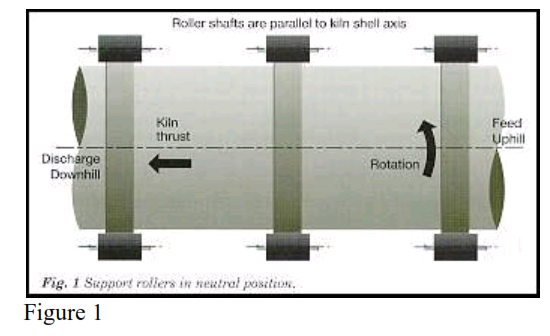
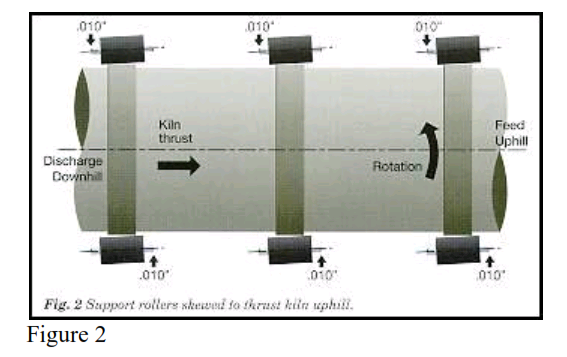
Two theories exist about training the axial thrust of the kiln. One is to have the kiln on the uphill- thrust roller for a portion of the revolution. The opposing strategy is to have the kiln on the downhill-thrust roller for approximately 30% of the kiln revolution. The latter method is preferable because it requires fewer support roller adjustments to obtain the desired amount of thrust. Further more, the downhill-thrust roller acts as an additional mechanism to push the kiln uphill. The amount of adjustment needed to train the axial thrust of the kiln can be minimized. Minimizing the amount of support-roller adjustments is beneficial because it will reduce the wear rate caused by roller-shaft skewing.
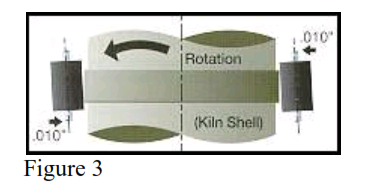
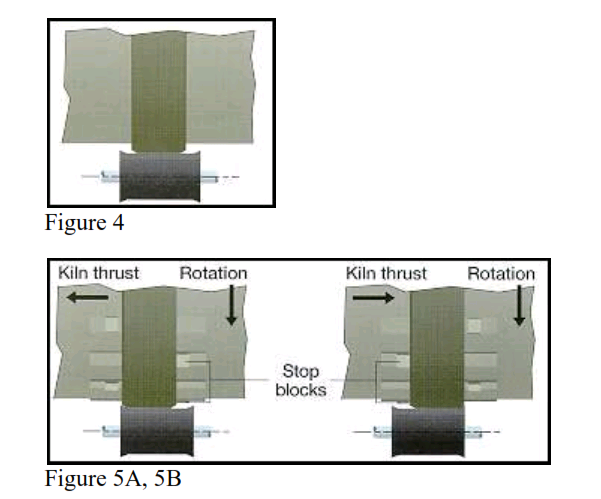
Fig. 3 Normal adjustment of support rollers, causing convex wear on tire and concave wear on rollers.
Fig. 4 Convex wear and concave wear on support roller as a result of normal adjustments.
Fig. 5A The kiln thrust is uphill hard, pushing the shell through until it contacts the stop blocks. The continued travel of the kiln will take the tire with it and force the tire against the uphill edge of the roller. If the thrust of the kiln is excessive, the uphill roller shaft can shift and cause hot bearing temperatures.
Fig. 5B The kiln thrust is hard downhill, pushing the shell through the tire to contact with the uphill stop blocks. Further downhill travel of the kiln will cause the tire to move the roller shaft downhill. Since most rollers are adjusted so the shaft is in a downhill position, the downhill thrust plate or collar will have high loading, and high bearing temperatures will result.
Concave and convex wear
Figure 3-The relationship between the surfaces of the support rollers and the face of the tire when the roller shafts are skewed to control the axial thrust of the kiln. Note that the axis of the roller shaft is no longer parallel to the axis of the tire. Consequently, the edges of the tire on both sides of the face will have higher load concentrations than at the center of the tire.
After the kiln operates in this condition for some time, the tire will have accelerated wear on its edges, giving it a convex shape. Since the support rollers are wider than the tire, the surface of the rollers will develop concave wear (see Figure 4). Since this is the desired adjustment position of the rollers to control the axial thrust of the kiln, this kiln design makes concave and convex wear inevitable.
The wear of the tires and support rollers will continue to require more support roller adjustments through the years to compensate for material lost during the wearing process. Increasing the amount of roller shaft skew in order to compensate for wear actually will accelerate wear on the tire and support rollers, as well as present the following mechanical complications:
- As concave and convex wear continues, the contact surface on the tire and support rollers will decrease. As a result, incremental moves on the bearing housings will increase proportionally to maintain the desired thrust of the kiln against the thrust rollers. For example, if a tire surface is 24 in. wide and the concave and convex wear decreases the contact surface by 2 in. on each edge, it is necessary to move the bearing housing .013 in. to achieve the results of a .010 in. move on a flat surface. If the contact surfaces decrease by 30%, it is necessary to increase the bearing adjustments by 50% to achieve the same results as when there is full contact between the tire and support rollers. The adjustments required to control the axial thrust of the kiln escalate the wear, and the kiln becomes difficult to control;
- As the kiln revolves, the contact between the tire and roller hardens a thin layer of metal on the contact surface. Since the roller turns approximately three times for every tire revolution, the roller surface becomes harder than the tire surface. The hardness relationship between the tire and roller is significant because stresses in the metal on the edges of the tires and rollers will cause cracks and surface spalling. The situation is compounded by the movement of the kiln uphill and downhill with atmospheric conditions such as temperature changes, rain, snow, or excessive dust. When the kiln moves uphill or downhill, the tire is forced against the high edges of the support rollers, intensifying the existing loads and resulting in broken edges on the tire and support rollers;
- Another important consideration with convex and concave wear is the possibility of high bearing temperatures and subsequent bearing failures. If the surfaces of the tires and rollers wear to the point that the tire is not free to move uphill and downhill on the surface of the support roller, the tire will force the roller to move in the direction of the kiln thrust (Figures 5A & 5B). The roller shaft will be forced against the thrust collar or thrust plate and high heating temperatures will result. If plant personnel are not quick to respond and make adjustments to change the kiln thrust, the bearing will overheat and fail. This situation can become critical because the kiln will change thrust direction for a variety of reasons and plant personnel constantly will be making adjustments to stabilize it;
- The concave and convex wear on the surfaces of the tires and support rollers will cause a drag that will increase considerably the amperage use. In evaluating the kiln’s operational performance over the years, there is a tendency to disregard the amount of energy required during production. This is a mistake, because energy consumption is directly related to the efficiency of the kiln operation. Excessive wear on tire and roller surfaces will decrease the operating efficiency proportionally, thus increasing energy consumption. It is not uncommon to find kilns using 25% to 50% more amperage strictly on the basis of the tire and roller wear. Furthermore, the drag caused by the worn tires and support rollers will introduce wear in the drive system that will accelerate drive component problems.
Conical wear
Conical wear, or radial taper, of the tires and support rollers exists when the diameter of the tire or support roller is smaller on one side of the face (see Figure 6). Speculation abounds about the causes of conical wear. Several conditions are present when conical wear is detected. The main condition is that the roller shafts are adjusted so their axes of rotation are not parallel on each pier (see Figure 7). This skewing of the support roller shafts often is caused by plant personnel losing track of the adjustments made on the support rollers. If this condition is excessive, an acceleration of wear will quickly produce cone shaped tires and support rollers.
Roller shaft skewing also is used to relieve the axial thrusting of the tire against the stop blocks or retaining bands. In some cases, settling of the concrete support piers will cause the structural steel bases to deviate from the original design slope. The difference in the base slope will cause a tilting of the roller shaft in the vertical plane that will create a gap between the surface of the tire and roller. Plant personnel often close the gap by moving in the bearing housing on the side of the gap. This mistake is common when lead wire is used to adjust for contact on the surfaces of the tires and support rollers. As a result of these types of roller adjustments, conical wear will begin and will increase with time.
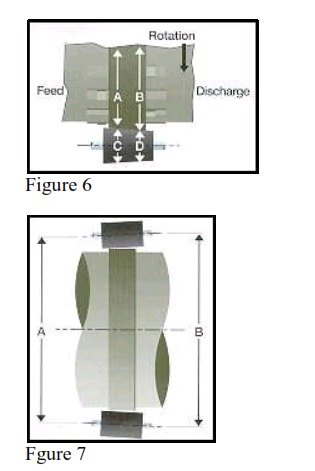
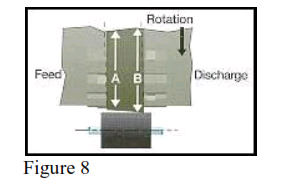
Fig 6 Diameter A is smaller diameter on tire; Diameter B is larger diameter on tire; Diameter C is larger diameter on roller; Diameter D is smaller diameter on roller. (Note: With this condition the tire will be pushing against discharge side stop blocks.)
Fig. 7 Support rollers are adjusted so roller shafts are not parallel. Dimension A is less than
Dimension B.
Fig. 8 Diameter A is smaller diameter on tire; Diameter B is larger diameter on tire. Dotted line shows the inclination of the tire to tilt towards diameter A or smaller diameter. The feed side blocks hold the tire in place, but this causes excessive wear.
Whatever the reasons for conical wear, the condition is undesirable for the same reasons outlined in the section on concave and convex wear. Furthermore, there are a few additional concerns:
- Since the tire diameter is smaller on one side of the tire face, surface loading is not evenly distributed. Consequently, the tire’s axis of rotation will tend to tilt toward the side with the greater load. However, the tire cannot tilt because the support rollers and the stop blocks are holding it perpendicular to the shell axis. Since the stop blocks are resisting this inclination of the tire to tilt its axis, a tremendous load is placed on the stop blocks. It is not unusual to see a .015 in. taper on the radius of the tire cause excessive loading of the tire against the stop blocks. This seems like a small discrepancy, but it would be similar to installing .060 in. shims under the bearing housings on each side of the tire. The high tire loading will eventually break the welds on the stop blocks and support pads. If the loading is excessive, the tire will lift the stop blocks completely off the support pad. The broken welds and damage caused by the tire loading on the stop blocks is one of the most bothersome areas of kiln maintenance during shutdowns. Newly designed floating support pads will decrease the weld cracking caused by thermal expansion, but tire loading will continue to introduce cracks and damage to these parts
- In the case of the tire loading on one side of the surface as a result of the conical wear, the inside diameter of the tire will create a higher loading on the out side diameter of the support pads. The ensuing frictional wear will cause the tire and the support pads to wear excessively and the gap between the tire and support pads will increase. As the gap increases, the shell will flatten at the top portion and high shell ovality will result. Shell ovality is a critical maintenance concern because of ovality’s affiliation with premature brick or refractory failure. Furthermore, the gap is directly related to the creep of a tire, and the creep will increase with the gap. The wear will accelerate on the support pads, escalating the relative movement between the tire and the stop blocks as the gap fluctuates at the top of the shell. When the gap opens, the tire will lift the stop blocks, and when the gap closes, the tire will release the stop blocks, creating a fatigue-type loading on the stop- block welds;
- A condition related to the conical wear of the surfaces of the tire and support rollers can present a problem if it is excessive. On the contact surface between the tire and support rollers, the diameters will vary in size because of the conical wear. Since the tire and roller are turning at the same speed, the induced slip, or drag, that occurs can cause high stress areas on the surfaces. Excessive slip or drag can result in stress cracking or surface spalling. At the very least, the existing drag between the contact surfaces will require additional amperage to turn the kiln during normal operation.
Tire and roller wear is often the consequence of normal kiln operation. The above-mentioned wear patterns were problems within the industry for many years without much hope of relief until the resurfacing process was developed. The means now are available to remove the wear and restore flat surfaces to the tires and support rollers. The resurfacing process can greatly assist plants experiencing wear.
The resurfacing process
One of the primary benefits of the resurfacing process is that all the work can be performed while the kiln is in normal production. Modern technology has provided the means to take all circumferential measurements of the tires and support rollers with electronic devices. The readings assimilated make it possible to hold a machining tolerance of .005 in. on the radius.
The accuracy gives the tires and rollers a like-new surface with the exception of one major point: New parts are machined in a controlled environment, but are not machined to match each other.
For example, a new tire is machined so the outside diameter (OD) and the inside diameter (ID) are concentric. However, the tire is not machined to revolve on the kiln shell’s axis of rotation. The tolerance of the shell and the tire are such that a fair amount of runout will exist between the tire
ID and the shell OD and some misalignment will be present when the parts are assembled in the field. For this reason, even in this new installation, the parts may wear.
The resurfacing process machines the tire as it revolves on the axis of rotation of the kiln shell, thus achieving better tire to-shell concentricity. The actual machining process can be performed in many ways: a cutting tool mounted on a fixture that traverses the tire and roller face, a belt grinder attached to a type of lathe bed, or a cup grinding stone attached to a machine similar to a centerless grinder.
Using the cutting tool arrangement has a tendency to remove too much material and it is difficult to cut a flat surface. Too much material removal will leave deep tooling marks that can be the cause of adjustment problems with the support rollers during and after the machining process.
The belt grinder is more effective but may leave waves in the surface as it traverses the face of the tires and rollers. The resulting highs and lows on the tire and roller surfaces can create problems in making minimal support roller moves to control the axial thrust of the kiln.
A properly designed grinding machine with a cup grinding stone is designed to sense the highs and lows in the surface of the tires and rollers as it traverses the face. The machine has devices that sense the out-of round conditions on every tire. With this type of machine, an operator can machine a tire in a manner that eliminates timing marks, as well as the highs and lows in the surface, while reducing the chatter caused by inconsistent machining conditions.
It is important to realize how the resurfacing process complements the hot kiln alignment process. The hot kiln alignment will not have the best results with out alleviating the wear conditions on
the tires and support rollers. Removal of the wear makes it possible to complete the alignment and reach optimum mechanical stability and efficiency of the kiln. With the two processes combined, the components will be relieved of accelerated wear and normal production of the kiln can be achieved with less energy.
Because of the energy savings generated by the resurfacing, payback for the alignment and resurfacing work can be only one year. Since all work can be performed during normal production, no costly downtime is needed and plant operation is uninterrupted. This resurfacing process is just one more way to increase the effectiveness of the kiln operation and also save maintenance dollars and energy costs for years to come.
Kiln maintenance: unnecessary expense or profit generator?
It may be argued that the expense of modern kiln maintenance procedures is quickly returned in profit increases
Rising energy costs, increasing labor costs, and lost production through equipment failure are serious problems that cement manufacturers are facing as they struggle to survive in today’s competitive markets. These three maintenance-related areas seem to be some of the few avenues open to control the upward spiral of today’s operating costs. Efficiently planned and executed maintenance schedules cannot only reduce operating costs but can also directly influence profit margins.
However, many cement plants are reluctant to spend money on kiln maintenance. The issue that faces today’s plant manager is this: Is planned kiln maintenance just an operating expense that can be postponed if the budget is tight or should it be perceived as an investment that can increase the profitability of a company?
This article will illustrate how some cement plants have used two basic kiln maintenance procedures to decrease operating costs and reduce energy usage, while increasing production levels and profit margins. These kiln maintenance procedures are tyre and support roller resurfacing and in-production mechanical analysis (‘hot kiln’ alignments). Before describing three case studies that illustrate how these procedures impact profitability, some basic kiln-related terminology and concepts will be discussed.
Concave and convex wear
Concave and convex wear is a common occurrence on the surfaces of tyres and support rollers. As pictured in Figure 1, concave wear is typical on the support rollers and convex wear is more prevalent on the tyre. The wear develops when support rollers are over-skewed to control the axial thrust of the kiln. The severity of wear is proportional to kiln loads and environmental contamination near and around the rolling surfaces. Severe cases of convex and concave wear can develop which will significantly restrict the travel of the tyre as the kiln changes its direction of axial thrust. When certain conditions exist, it is possible to damage thrust collars, thrust plates and other related components of the bearing housing assemblies. Since the actual load surface of the tyre and rollers is reduced, wear will accelerate and greater bearing adjustments will be necessary to control the axial thrust of the kiln. This will result in a significant frictional drag between the bearings and the roller shaft that will increase loading on the kiln drive system.
Uneven wear
As shown in Figure 2, uneven wear is usually caused by product or dust contamination passing through the contact point of the tyres and support rollers. This type of wear can also develop when rollers run in product build-up in the pits of the support roller structural bases. Severe uneven wear causes a poor transition surface for the tyre and support rollers which will hinder the axial movement of the tyre. This wear condition generates a frictional drag on the kiln drive system and can cause high contact pressures on the rolling surfaces if sufficient wear exists.
Tapered or conical wear
Radial taper on the surfaces of the tyres and/or the support rollers is one of the most difficult types of wear to detect. One noticeable indication of this wear condition is the axial loading of the tyre against the retaining bands/blocks. Tapered wear is an undesirable condition because the tyre will move toward the loaded side of the contact surface. Figure 3 shows an example of conical wear. A taper on the tyre or roller will generate wear on the support pads and tyre ID and will make
support roller adjustments difficult. The wear on the support pads and tyre ID will accentuate the gap between tyre and shell, subsequently increasing the percentage of shell ovality. When this wear condition exists, there is often a significant amount of roller misadjustment that will increase
the frictional drag on the kiln drive system. The inclination of plant personnel is to adjust rollers to close the gaps between tyres and rollers. This method of adjustment will create a misalignment of the roller shafts with the tyre axis generating unequal axial thrust.
Diagonal marks
Diagonal marks are evident when there is incorrect adjustment between the support rollers and the tyre. The support rollers are adjusted so the axis of rotation on each roller is not parallel. Consequently, the tyre does not have a smooth rolling surface and frictional drag results, generating tapered wear on the surfaces of the tyre and support rollers. This condition creates a high torsional load on the shell that hinders the smooth operation of the kiln drive system.
Horizontal marks
Like diagonal marks, horizontal marks develop when the support rollers are incorrectly adjusted and/or misalignment of the drive gear and pinion is present, Figure 6. Although this condition is more common on two-pier higher speed kilns, it can also exist on the large, slower kilns. Sometimes the misadjustment does not occur between two rollers on the same pier. Misadjustment can be present when rollers on adjacent piers are adjusted to thrust in opposite directions. If this condition is present it will cause rough operation of the drive gear and pinion. Additionally, the torsional loading on the kiln will increase, resulting in a drag in the kiln drive system. The wear conditions are generated by many different circumstances which can not be covered at length in this article. Individually or collectively, these wear patterns will influence the overall efficiency of the kiln drive system and will require a greater allocation of maintenance expenditure and plant labor to effectively operate the kiln.
Tire and support roller resurfacing
Tyre and support roller resurfacing is the process of removing various types of surface wear. The actual grinding process is performed in-place with no production downtime so the work does not interrupt the normal operation of the kiln. As the wear is removed, adjustments are made to the support rollers to locate the roller shafts as close as possible to a neutral thrust position. The removal of this wear and the balancing of the support roller thrust will notably diminish the frictional drag placed on the kiln drive system, in addition to stabilizing the axial thrust of the kiln.
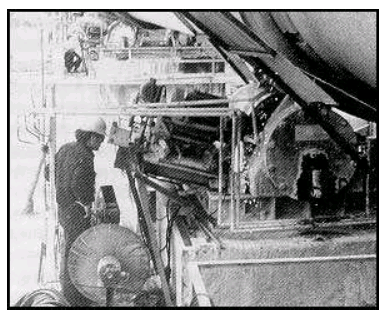
Hot kiln alignment
The method of alignment employed on a kiln, must achieve two fundamental principles. Accurate measurements must be taken when the kiln is in operation to determine pier loading. The operating axis of the kiln shell must be identified and defined in relationship to the slope of the
support rollers. A straight shell axis during normal kiln operation will reduce the frictional drag on the drive system, decrease the shell deflection or ovality due to excessive pier loading, and greatly reduce the adjustments needed to control the axial thrust of the kiln. If these three improvements are realized, kiln drive amperage will be reduced, the likelihood of refractory failure will be diminished, and kiln maintenance costs will decrease. Two common kiln alignment variances can affect the straightness and stability of the shell, as well as its operational efficiency.
Incorrect elevation axis of the kiln
An incorrect elevation of the kiln axis exists when the kiln shell does not have an axis of rotation that is consistent with the slope of the structural steel bases, as illustrated in Figure 9. Shell slope will not match tyre and roller slope and high axial thrust will be present on the related piers. The tyre will have high axial loads against the retaining blocks/bands if this condition exists. Higher loads will be placed on the bearings which will create higher Hertz pressures on the roller shafts and the bearing liners. Frictional drag will eventually occur between the tyres and rollers causing torsional loading of the shell between the respective piers. Inevitably, the torsional drag will cause a significant increase in the amperage needed to operate the kiln.
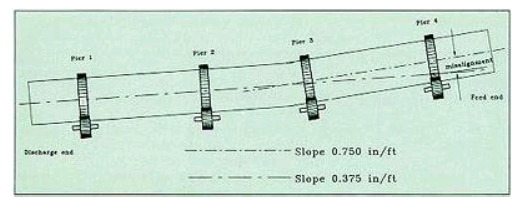
Misalignment of the kiln in elevation is common because of the thermal expansion of the kiln. If the kiln is aligned while it is out of production and cold, consideration must be taken to position the kiln where the axis will be after thermal expansion of the shell, tyre and rollers. This position is difficult to determine because the shell is not uniform in temperature (it is higher in the burning zone than at the feed end). Brick thickness and environmental conditions can make it nearly impossible to prevent elevation misalignment of the kiln shell unless that alignment is performed while the kiln is operating. The elevation alignment affects the kiln drive amperage. Contrasting loads will be placed on the individual support rollers. It is evident in Figure 9 that there will be more loading of the #1 and #4 piers support rollers. Since these support rollers will carry more than their share of the design loads, the Hertz pressures will be higher between the roller shafts and the bearing liners. Consequently, a frictional drag will result between the bearing liners and the support roller shafts, initiating a load on the kiln drive system that will result in higher energy consumption to rotate the kiln. Furthermore, shell ovality will be higher on the loaded piers and
for this reason, measuring shell ovality is a necessary function of a hot alignment, (Figure 10, item 2).
Incorrect plan view shell axis
An incorrect plan view axis of the kiln shell will result in loading problems similar to those found with elevation misalignment, with one exception. The vertical slope is not a consideration in the plan view. However, it is interesting to note that the elevation misalignment will influence or heighten the reaction caused by a plan view deviation from the design axis of the kiln. A deviation of the shell axis in the plan view will result in a reaction even if the elevation axis of the shell is correct.

With a plan view misalignment, the axis of the roller shafts will be affected by the plan view axis of the kiln shell. Figure 11 relates the effect of the kiln axis in the plan-view plane as it compares to the axes of the respective roller shafts. This diagram shows a kiln shell with a distinct curve to one side. Notice how the axis of the shell relates to the axis of the respective support rollers. Ovality readings will also demonstrate that one roller on this pier is taking more load than the opposite roller, (Figure 10, item 6). If the discharge end support rollers are adjusted to have full face contact with the tyre, the roller axis will correspond to the axis of the shell. The bearing on the feed side will have a shorter distance to travel to reach the desired axis than the bearings on the downhill side of the tyre. For this reason, it is best to swap the position of each roller shaft intermittently when making alignment moves on the support rollers. Shell alignment as outlined here will cause an unstable condition with the axial thrust of the unit, and again generate greater energy requirements to rotate the kiln.
In addition to the apparent problems created when elevation and plan-view shell misalignments place torsional load on the shell of the kiln, an additional concern is the effect of the torsion on the brick or refractory. The resistance of the kiln shell to rotate because of the tyre and roller wear and a shell misalignment condition puts the shell in high torsional stress, creating an unstable environment for the bricks. Since the installation of refractory brick does not allow for torsional movement, any significant amount of loading may result in premature refractory brick failure. When examining various conditions that will generate a torsional loading of the kiln shell and reduce the energy efficiency of the kiln drive system, it is evident that the following considerations affect the operating kiln.
Wear on the surfaces of the tyres and support rollers will generate high hertz pressures on the contact surfaces, induce frictional drag between the roller shafts and bearing liners and make it difficult to control the axial thrust of the kiln with minor roller adjustments. Kiln misalignment will place a bind on the kiln shell and higher loads on the respective support piers. Minor support roller adjustments will be difficult to perform. Because of component wear and the kiln shell misalignment, the torsional loading of the shell will decrease the energy efficiency of the drive system and generate wear on the drive components. Since the above conditions affect the ability to perform minor support roller adjustments for controlling the axial thrust of the kiln, the rollers will probably be misadjusted. This will create additional wear on the component parts and the amperage required to rotate the kiln will increase. It is important to note that as the energy increases to turn the kiln, the additional energy to overcome the frictional drag creates additional wear on the component parts of the drive system, the tyres, and support rollers. Furthermore, productivity will decline and maintenance requirements of the kiln will increase.
To achieve maximum efficiency of kiln production, it is evident that a hot kiln alignment should be performed in conjunction with the tyre and roller resurfacing. The following case studies of three manufacturing plants substantiate the effectiveness of these two maintenance procedures in increasing productivity and operating efficiency. These advantages are enhanced when one notes that both the resurfacing and alignment procedures can be achieved with no production downtime. Resurfacing and Alignment case studies
Case One: A 6-pier, Allis-Chalmers wet-process cement kiln in the Western United States was not operating to design specifications or production standards. Amperage readings were high and at many times unstable. The refractory brick life of the kiln was unsatisfactory and the brick would seldom last through an annual campaign. Plant personnel were constantly called to make roller adjustments to control the axial thrust of the kiln. The kiln was designed with hydraulic thrust rollers on the downhill side of the middle piers. As the kiln moved uphill, production was halted until adjustments could be made to move the kiln downhill. Production was lost because of frequent kiln outages and maintenance costs were magnified. This was a distressing circumstance as the plant was sold-out and thus sales from lost production could not be regained. In simple terms, they were producing less clinker at a greater operating cost and losing profits from the lost sales.
An inspection of the unit indicated misalignment of the kiln axis and a significant amount of wear on the tyre and support roller surfaces. Further examination revealed that support rollers were adjusted sporadically throughout the length of the kiln shell so that some rollers were pulling the kiln uphill and the remaining rollers were pushing the kiln downhill. The recommended course of action was to repair the worn surfaces of the tyres and support rollers with the resurfacing procedure followed by an in-production mechanical analysis or ‘hot kiln’ alignment.
The resurfacing procedure was performed in conjunction with support roller adjustments to eliminate the volatile thrust condition of the kiln. Adjustments were made to each individual support roller to locate the neutral position of the roller shafts. After these adjustments were achieved, small incremental moves of the bearing housings were made to control the axial thrust of the kiln. After the wear conditions on the tyre and roller surfaces were eliminated and the axial thrust of the kiln was stabilized, the frictional drag on the component parts was significantly diminished.
The next phase of the project was to perform the mechanical analysis or ‘hot kiln’ alignment. The goal of the mechanical analysis was to identify the reason for the inferior brick life and to determine the exact location of the kiln shell operational axis of rotation. Ovality readings were performed and a complete survey of the elevation and plan view position of the kiln shell axis was computer analyzed. Structural steel support bases were measured for actual slope and compared with the actual slope of the support roller shafts. The kiln was found to be out-of-position in the plan view significantly on the discharge pier. In addition, some other alignment discrepancies were apparent.
Arrangements were made to perform support roller adjustments to position the kiln shell at the correct operational axis. The adjustments were made over a period of several weeks to maintain the delicate axial thrust of the kiln and to eliminate any production delays as a result of the process. Both the resurfacing and alignment procedures were completed without any delays in production. Maintenance department participation was held to a minimum.
The results of the combined procedures were excellent. The production of the kiln increased by 25% immediately after the work. Kiln drive amperage has remained an average of 15% lower since the project was completed. The life of the refractory brick increased allowing a full year’s service without kiln-related brick failure. The overall plant efficiency increased by 5%. Support roller adjustments to control the axial thrust of the kiln were virtually eliminated. Effectively, the profits of the plant increased significantly.
Case Two: A 4-pier, F.L Smidth kiln at a plant in Quebec, Canada. Similar misalignment and wear circumstances existed which exhibited operational problems. In this plant there were three other kilns that had similar operating problems as the subject kiln. Control of the axial thrust was difficult, requiring an excessive amount of maintenance manpower. Brick life was inadequate and production output was reduced. All of the product produced at this plant was sold in advance so that any production down time associated with these maintenance problems resulted in lost profits.
After the resurfacing and ‘hot kiln’ alignment procedures were performed, the drive amps on the subject kiln dropped from 190 amps to 150 amps, the daily production increased from 80 tph to 110 tph, and the operating efficiency of the kiln increased to 95%, up from 75%. After realizing these results, plant personnel performed the same maintenance procedures on the three remaining kilns. Similar improvements in amperage, production, and operating efficiency resulted. Company officials saw a phenomenal increase in the operating profits of this plant.
Case Three: A plant in Minnesota, USA, had five large 22 ft. dia., Allis-Chalmers kilns for steel production that had serious operating problems. The drive system had serious frictional drag on the components generating high kiln drive amperages. Numerous hot bearings were causing lost production on a weekly basis, production capacities were unsatisfactory, and plant maintenance on the equipment was extensive. After analyzing the above conditions resurfacing and alignment were recommended and performed.
The results were impressive. The kiln drive amperage dropped from 595 amps to 345 amps on one unit, a 42% decrease. Since the additional amps were being employed in overcoming the frictional drag, a noticeable change was seen in the operating efficiency of the drive system. The hot bearing temperatures on the support rollers were eliminated completely. Consequently, an average of 12 hours per week of lost production on each drum was regained, increasing the productivity of the entire plant. Adjustments to the support rollers were no longer needed and maintenance on the kilns has been reduced to checking the bearings for thrust on a periodic basis. The initial cost of the maintenance work was recovered in a few months of trouble free operation at the design production capacities.
The documented results of the resurfacing and alignment procedures at these three sites clearly speak for themselves. Unfortunately examples can also be cited where the resurfacing and/or alignment procedures were done by in experienced crews and inferior or poorly designed equipment. The success stories like the ones mentioned here all have several things in common:
The technicians performing the work were highly trained and had years of experience in these kiln maintenance techniques.
The equipment used was specially designed and manufactured (and, in these examples, patented). The procedures used were advanced (also patented), proven reliable, and extremely accurate.
The resurfacing process and the in-production mechanical analysis have been successfully performed in North America for many years. Cement companies in many parts of the world are now utilizing these procedures to assist with the mechanical maintenance of their equipment. Performing these procedures will make kiln maintenance simpler and more effective. That fact makes resurfacing and kiln mechanical analysis worth their cost. These maintenance procedures become more important to cement plants when their effects on company production levels and profit margins are considered.
The issue of whether cement plants consider maintenance an unnecessary, expensive evil or an investment for improving company efficiency and profitability has been the focus of this article. As demonstrated by the aforementioned case examples, resurfacing and in-production mechanical analysis can indeed be used to generate profits through decreased energy consumption, reduced maintenance costs, and increased plant efficiency.
The costs of maintenance procedures are quickly recovered in short term profit increases (with a payback of a few short months in the examples cited). Since the normal rate of kiln wear occurs over a number of years, the long term profitability of kiln maintenance is even more attractive. Equally important, the environment benefits through lower energy consumption and increased efficiency. Resurfacing and in-production mechanical analysis are maintenance procedures that can assist with all these goals.
The Direct Method
The Direct Method
The kiln must be aligned so that flexing and distortion of the kiln shell are minimized and that loads to the support bearings are properly shared . Flexing and distortion of the kiln shell vastly increases mechanical wear and tear and can severely reduce refractory brick life. Poor load sharing amongst the supports leads to roller and bearing problems as well. The Direct Method of alignment is used to find the shell centre points to be aligned without any measurement to the support components, namely the tyres or the rollers, and this is done with the kiln in full operation.
The advantages of being able to do this would be self evident. Such a method would have the directness and inherent accuracy promised by a bore sight alignment and also the advantages of an external procedure, that is measuring the position of the shell hot and running. By definition it would then be the ideal preventative maintenance tool since it can be scheduled any time the kiln
is up and running. The fact that there is a rotating object, the shell, allows its centre of rotation to be found irrespective of the fact that it may not be circular and that it may have planetary motion. To do this it is only necessary to find three mean shell positions. Properly selected, these three positions will reveal the centre of rotation. The most important aspect to emphasize is, with the kiln in normal operation, the position of a series of support points have to be obtained by external measurement which can be aligned without knowing any details about the nature of the supports. This has been accomplished by finding centres of rotation as opposed to the physical centres of tyres and shell. Aligning these points then puts the shell in the lowest state of stress which can be achieved by positioning the support rollers.
- Introduction
- Historical preference for the internal bore sight alignment
- Limitations to the internal bore sight alignment
- Limitations of external procedures
- The Direct Method
- The apparatus
- A note on accuracy
- Final observations
- Conclusion
Introduction
Naturally, the intention is to establish alignment with the kiln in operation. The advantages of doing so are compelling. What is the Direct Method of alignment? – The Direct Method of alignment is to find the shell centre points to be aligned without any measurement of the support components, namely the tyres or the rollers, and doing this with the kiln in full operation. The advantages of being able to do this would be self evident. Such a method would have the directness and inherent accuracy promised by a bore sight alignment (Fig. 1), and also the advantages of an eternal procedure, that is measuring the position of the shell hot and running. By definition it would then be the ideal preventative maintenance tool since it can be scheduled.
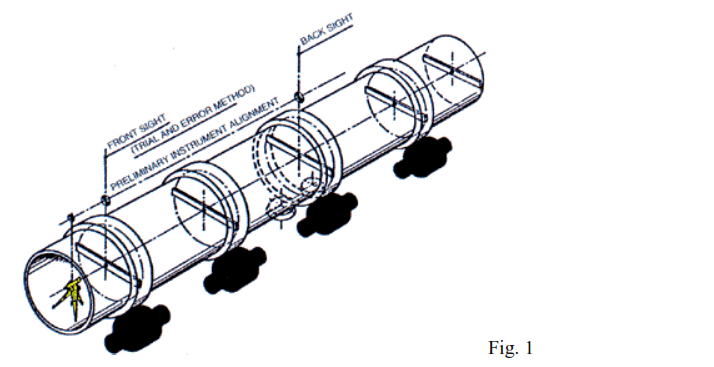
Historical preference for the internal bore sight alignment
Bore sight alignment (Fig. 1) is almost always used in the erection of kiln shells when they are delivered to site in more than one section. For all but the shortest kilns this is usually the case. Subsequently, after the kiln has been lined with refractory and set into operation many users still prefer to check alignment using this internal technique This is the most direct method of alignment measurement because, unlike external procedures, it circumvents the need to measure the support component geometries. That is its great advantage. Unfortunately this advantage is more than
offset by the need to shut the kiln down and have it 100% available for measurement. This is a shut down period where no other work can take place for the duration of the measurement work, and seriously detracts from using the alignment as a preventive maintenance tool. Working inside the kiln also presents physical challenges that compromise accuracy.
Limitations to the internal bore sight alignment
The internal bore sight alignment, in spite of the directness of shell position measurement, has some serious limitations. Each centre for a roller support station is found from a composition of several rotational kiln positions. As a minimum, 3 positions are necessary. More are preferred since the location of the centre, measured from the inside surface of the steel shell, will gain precision with the number of shell reference points. Each point, however, requires the coating on the brick, and the refractory brick itself, to be drilled. In addition, for each set of points the kiln
has to be partly rotated. It is easy to understand that this is time consuming and, with the pressures to limit shut down time, the minimum procedures are usually accepted. Another limitation is that the kiln is necessarily measured in its cold condition. Cold, the kiln is not thermally expanded. This means that the centres are not in the same vertical locations, and the tyres are not in the same axial positions in relation to their respective pairs of support rollers, as they would be with the
shell hot and expanded. Re- checking alignment after the roller adjustments have been made is not an option, at least until the next shut down.
Limitations of external procedures
To date, all external procedures (hot or cold), invariably take measurements to at least the tyre, and usually to the rollers as well. Whether these measurements are taken hot or cold does not matter to those procedures. These hot procedures are only variations and extensions of the
standard cold procedure, and in principle they are all identical. Preference is given to measuring hot to avoid the limitations of the internal procedure as described. Although a great variety of techniques are used to measure a moving tyre diameter, and hence compute its centre position, such efforts are plagued with accuracy problems. Even when the location of the tyre centre has been computed, it is the shell that must be aligned. Most kilns have migrating tyres, which means their shell position within the tyre is eccentric. This phenomenon must be accounted for. The hot external methods therefore still have credibility problems with knowledgeable critics in some segments of the kiln user industry.
The Direct Method
It must be appreciated that the accuracy of the final alignment is only as good as the accuracy and reliability with which these “centre points” can be established. The direct method establishes these centre points in the same way as a bore sight alignment, that is by measurement to the shell rather than through measurement of the support components. The same principle of trammelling points from the inside of the shell is thus applied although now working from one of the shell. There are some differences. Namely there is no restriction to three (or any number) of discrete shell positions. Theoretically, any number of positions can be used provided the computer and measuring device can handle them. As a result the shell centre of rotation is obtained, and not just a physical centre of the shell. It goes without saying, when working externally, that there is no refractory, material coating or sometimes kiln chain to impede the work. The fact that there is a rotating object, the shell, allows its centre of rotation to be found irrespective of the fact that it
may not be circular and that it may have planetary motion. To do this it is only necessary to find three mean shell positions. Properly selected, these three positions will reveal the centre of rotation (Fig. 2).
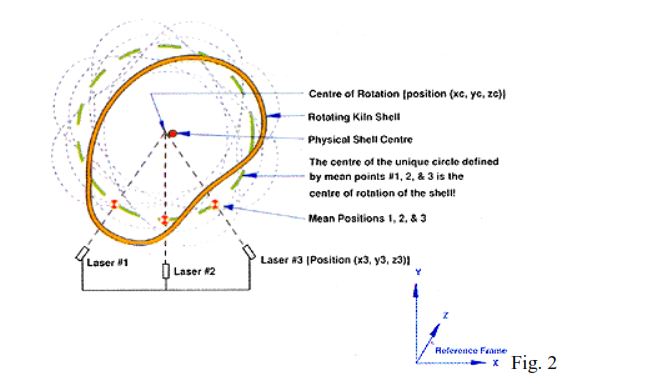
The dashed lines represent the rotation of the shell. Although only eight positions are indicated in this way the lasers each take 180 discrete readings during the course of one shell rotation. Technically, 180 shell positions should be shown but this would obscure the illustration. The 180 readings are arbitrary but are considered numerous enough to represent the entire surface of the shell. Each laser’s 180 readings are then averaged, producing three mean shell positions. Only one circle can be drawn through three points. The resulting circle does not really represent the shell, it is simply called the working diameter. The only significance of this circle is that its centre is the centre of rotation of the shell. If the shell had no component of planetary motion, which is virtually never the case given the nature of the shell, its physical centre would correspond to the centre of rotation. In practice the centre of rotation is always different from the shell’s physical centre as illustrated. The only thing that varies is the degree to which these points are separated. The centre of rotation at one cross section of the shell is found in this way. Performing this procedure once on the discharge side of each tyre and again on the in feed side of each tyre allows the interpolation of the centre of rotation for the centre of each tyre support. At this juncture a set of centres have been obtained, just like the bore sight method, the only difference being that the points are coordinate addresses in a 3 dimensional space. This then is the basic concept of the Direct Method. By definition it is clear that unlike other methods it can only be performed with the kiln in operation.
The apparatus
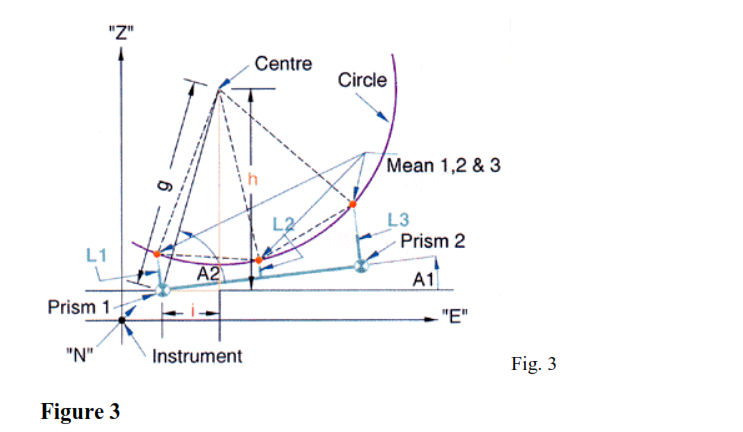
Figure 3 shows the apparatus. “Instrument” means the position of the Integrate Total Station which will have coordinates (Ni, Ei, Zi) where N, E, Z are in millimetres (45023, 9467, 6251) (Fig. 4).
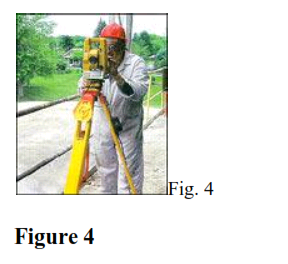
Prism 1 and Prism 2 denote the coordinate addresses of the two fixed prisms on the bridge, Pl (Npl, Epl, Zpl) and P2 (Np2, Ep2, Zp2) all in millimetres (Fig. 5). Ll, L2, L3 are variable dimensions com posed of a bridge constant, i.e. the physical location on the bridge which does not change from application to application, and the variable laser readings.
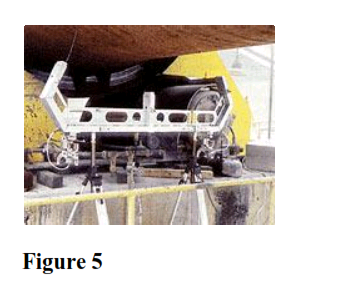
These laser readings are distance displacement measurements from the laser to the shell. The bridge assembly (Fig. 5) shows the three lasers, one centre and one at each end. Means 1, 2 & 3 are the computer calculated positions based on the respective averages of each of the 180 readings of Ll, L2 and L3. The three sets of 180 laser distance displacement readings are logged virtually simultaneously during the course of one shell rotation. The unique circle defined by the three means 1, 2 & 3 is shown to clarify the trigonometric calculation of the centre. Al is the angle the bridge makes to the horizontal. It is not necessary therefore that the technician sets the bridge level, although in most cases near level would be the most convenient for him. There are other criteria of placement which are adhered to. Adjustment capability ridge to facilitate this. A2 is an angle which will vary with kiln diameter. For the sake of brevity its derivation is not shown, but it is a simple trigonometric calculation given the bridge configuration and measured means 1, 2 & 3. Similarly, the derivations of g, h & i are not shown, but are also found by trigonometric calculation from the known points and distances. Centre; Given the bridge constants, that is the fixed relative positions of the three lasers and the two prisms, and the average of the three laser displacement readings it is therefore a straightforward trigonometric calculation to show that the centre coordinates are: Centre [Pl(N,,l), P1 where h=g sin(A1+A2) ,~d i = g-cos(Al+A2) The cross section of the kiln is at right angles to the “N” direction. In actuality this would be a rare coincidence. The kiln position is expected to be skewed to all axes since the coordinate grid is set before the kiln position is measured. The coordinates of the centres are therefore true three- dimensional addresses. The centre of the shell at the centre of the support frame is interpolated from the two centres straddling a support tyre. This then yields a single point for each support. Their positions with respect to a straight line of a selected slope is then easily assessed. All the calculations are computer based. Their details are not needed for an understanding of the basic precepts.
A note on accuracy
Every kiln installation provides its own challenges that compromise the inherent accuracy of the instrumentation brought to the task of alignment measurement. In this sense the instrumentation described here is no more or less susceptible than that associated with any competent procedure. Absolute accuracy is therefore site specific. It goes without saying that instrument accuracy is always greater than the accuracy of the final results. So far the only concern has been to find the shell position. Any misalignment of the kiln position must now be translated into roller adjustment to correct the position. This requires a knowledge of the roller and tyre diameters. The advantages of the Direct Method measurements are best explained by example, which will also demonstrate why this method is inherently more accurate. A convenient set of tyre (7,000 mm) and roller (2,000 mm) diameters will be used for the kiln taken as an example (Fig. 6).
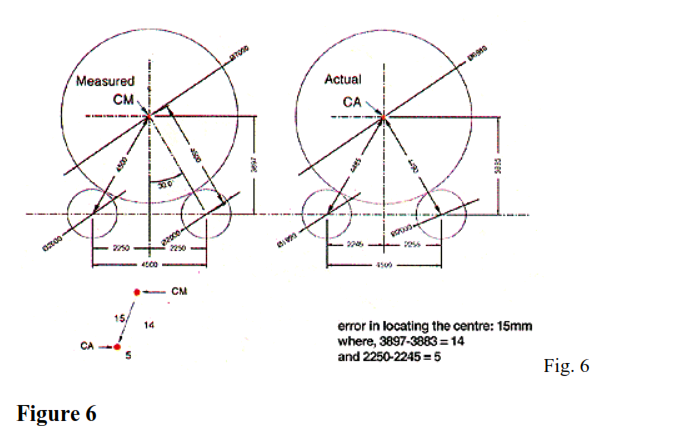
Consider first one point from a set of centres calculated using an external procedure. It will then be assumed that two errors were made. First, the tyre diameter is actually 6,980 mm, and secondly one roller diameter is actually 1,990 mm. The practitioner who does not know this but calculates his centre point through his support component measurements will mislocate the centre by 15 mm. Any variation of diameter errors or roller spacing mismeasurements will have similar results. The error in this case is 15 mm. Now to be fair the same error hypothesis will be imposed on the Direct Method. Having measured the alignment without having to know any of the diameters, a misalignment is indicated of 10 mm vertical direction and 10 mm horizontal direction. From this position it is necessary to calculate the appropriate roller moves to reposition the kiln, for which the diameters must now be introduced. For the horizontal correction both rollers can be moved to the right 10 mm (Fig. 7).
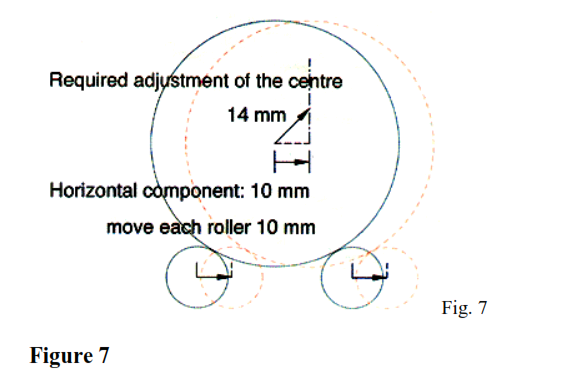
Next, the vertical correction must be calculated. First using the measured values, then with the actual values.
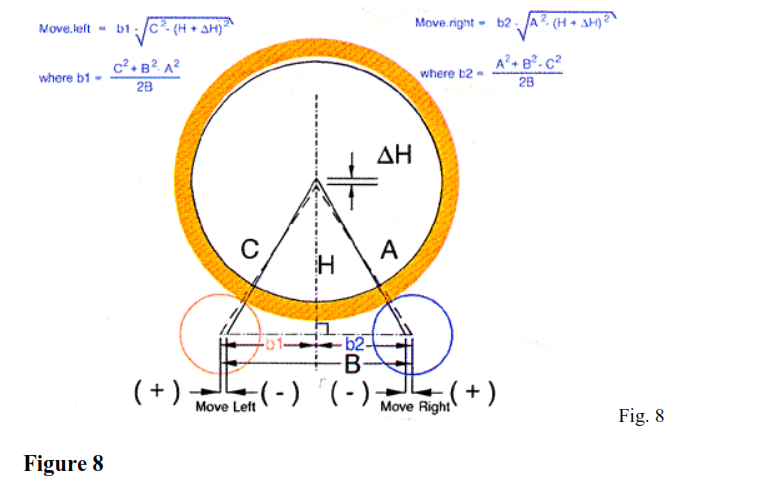
Shown in Fig. 8 is the calculation for the vertical adjustment. An actual value for DH of 10.16 mm was calculated backwards from having moved 17.41 but using the actual A, B & C values. The measurements of A, B & C are crude because of the nature of the kiln. However, it is clear that the error in placing the rollers is barely affected by using poor values for A, B and C. Using quick and simple measurements to verify these dimensions for the purpose of roller support movement calculations therefore hardly affects the results for the Direct Method. This is why the accuracy of obtaining an alignment measurement is totally independent of the condition of the rollers and tyres and the effect on roller adjustments is negligible. Unlike the simple external procedure which produced a 15 mm error in placing the centre, the Direct Method resulted in only a 0.16 mm error with the same mistaken roller and tyre dimensions. The inherent accuracy for this example is almost 100 times better. Even if the horizontal spacing is in error it can be clearly seen that the Direct Method has inherently better accuracy
Final observations
The most important aspect to emphasize is that the positions of a series of support points have been obtained externally with the kiln in normal operation without knowing any details about the nature of the supports. This has been accomplished by finding centres of rotation as opposed to the physical centres of the tyres, shell, etc. In retrospect, it is considered that the centres of rotation are more representative of the dynamic position of the kiln. Aligning these points then puts the shell
in the lowest state of stress that can be achieved by positioning the support rollers. Although there is always a measurable difference between the centre of rotation and the physical centre of the shell, this difference for all except kilns in poor mechanical condition is somewhat academic. In other words, most times it makes no significant difference. But, apart from not knowing in advance the kilns for which it does make a difference, the real advantage of focusing on the centres of rotation is that they represent the dynamic position of the shell during operation. Hence the name “direct”. Although the Direct Method is principally the same as the internal bore sight method, but carried out in an “in side out” fashion, it is not restricted to discrete shell positions. In addition, there is not only a vastly increased volume of data for supporting the calculation of the centre positions, but also the option is available of repeating and verifying positions after roller adjustments or at any time for whatever reason. The Direct Method of alignment also includes ovality measurements. Ovality is the measure of the dynamic change of shell curvature caused by rotation. Ovality is of primary interest with regard to the mechanical stability of the refractory lining. However, a detailed analysis of the curves as presented by the electronic ovality beam often reveals information useful in completing an alignment analysis. Significant differential ovality from one pier to the next can be used to correct the alignment recommendations when appropriate.
Conclusion
The kiln must be aligned so that flexing and distortion of the kiln shell are minimized and that loads on the support bearings are properly shared. Flexing and distortion of the kiln shell vastly increases mechanical wear and tear and can severely reduce refractory brick life. Poor load sharing amongst the supports leads to roller and bearing problems as well. Measuring alignment, with the kiln in full operation, accurately and reliably, requires an innovative approach. The Direct Method is that innovation making it a truly preventative maintenance tool. Now it is possible to align an operating kiln precisely.
The New Bore Site Alignment
The New Bore Sight Alignment
Using the Centers of Rotation for Bore Sight Alignment of Rotary Kilns Walter M. Gebhart P.Eng., Vice President, Phillips Kiln Services Ltd. Ronald W.T. Birchard P.Eng. Consultant rwtbirch@cgocable.net
Dave Roberts Manager, Alignment Services, Phillips Kiln Services Ltd.
Introduction
Although “The Direct Method”1 for measuring the alignment of rotating kiln shells has become a procedure of choice for many kiln operators world wide, it has one limitation. The kiln must be in operation in order to make the measurements. For the most part this is a strong advantage but when major repair work is underway, such as changing a shell section, where aligning the new section is a critical step, a bore sighting may still be necessary. Techniques involving rotation to align the field joints of the new section(s) still have the advantage but there are situations where
this may not be possible. An example of that may be a kiln with planetary coolers when one of the field joints is between the inlet area of the coolers and the supporting tire immediately up-hill of this area. Securing the shell joint sufficiently to permit turning for the purpose of alignment may be prohibitive. In such a case a “bore sighting” as has been done for decades is the obvious solution.
The adaptation of some standard alignment techniques can make bore sight measurements significantly easier to perform than what is conventionally done2 .
The Direct Method1 (performed while the kiln is in normal operation) utilizes the turning shell to identify the point about which it rotates at each roller support. A typical bore sight procedure2 (always performed with a cold, shut-down kiln) involves setting up physical target plates inside the kiln on which a center is determined by direct measurement from the inside of the shell plate.
This requires removing areas of refractory at each roller support station to expose sufficient areas to do this. See Fig 45.2
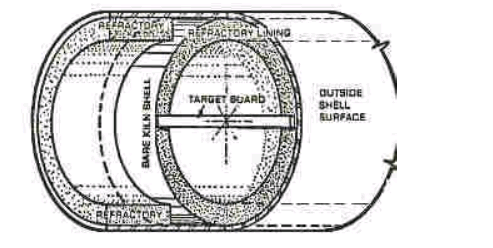
The Direct Method, a hot alignment technique (performed while the kiln is in normal operation) was developed from the principle of the bore sight. The Direct Method does continuous scans on the outside of the moving shell to determine a center of rotation. The center of rotation is virtually always different from the mean shell center. This may be academic in most cases but significantly the center of rotation is more accurately and reliably identifiable. The bore sight using the center of rotation instead of the mean shell center, is less work as well. The reason for this is because there is no need to measure to the inside of the shell. It is also possible to fix the target stands without refractory removal. This means significant savings of time and labor. Additionally it is done with far fewer rotations than that necessary to “trammel in” the centers compared to the conventional method 2. Thirdly the center of rotation is established entirely independently of the shape of theshell. This last point may often be the most significant in terms of accuracy since a distorted shell introduces uncertainty in determining a mean shell center. Finally, if done carefully, the effects of ovality (shape distortion due to flexing) can also be all but eliminated.
This is an ironic development since the bore sight inspired the development of the external, hot alignment, “Direct Method” procedure, and in turn, the Direct Method is now used to redefine the bore sight technique.
The New Bore Sight Alignment
The following is not meant to be a definitive description of the new bore sight alignment methodology but a simple outline so that anyone not familiar with the procedure can grasp a general appreciation of it.
Establishing the axis of rotation is done after the kiln is shut down but before any cutting of the shell commences. The shell is then cut and the replacement section can be aligned to that axis without rotating the shell.
An alignment scope (one equipped with visible laser light is a very convenient tool in this case) is placed immediately outside of the kiln. This is typically at the discharge end on the burner floor with the hood set aside. A position is roughed in using a tape measure etc. to place the instrument’s optical center approximately near the center of the open ended shell. Two positions along the interior length of the shell are then selected as target locations. We can assume the typical scenario where, on a three pier kiln, the first 20 meters of shell, including the first tire
section, will be replaced. We would then select the center of tires two and three as reference target locations. At each of these reference positions target fixtures are installed. This fixture is usually a robust post welded to the shell, reaching radially inward to the center where a target plate is attached. This requires some refractory removal, perhaps only two bricks at the base of each post.
Also possible, is using a fixture which spans the diameter of the kiln, one leg firmly anchored into the refractory, the other leg firmly held against the refractory by a spring of considerable force. At the center is its target plate. There are certain physical requirements for this target fixture such that it does not sag when suspended horizontally inside the kiln and such that its movement, as a result of kiln shell flexing, is minimized. Two such target fixtures are then placed at the desired locations with the target plate roughly centered in the open area of the interior of the kiln. The advantage of not having to remove any refractory with this type of fixture is offset by the need for having such correctly designed fixtures available. The soundness of the refractory in those locations is then
also an issue to be dealt with. In either case the target stands should be in-line along the length of the shell. On a case by case basis, judgement needs to be exercised in deciding on which fixtures to use.
With targets now in place the shell is rotated to a position where the fixed end of the target stands are positioned at approximately 3 o’clock. The scope is then aimed at the farthest target, Fig A. The spot on which it is focused is then marked on that target. Then, sighting the near target, a spot is marked on it. The roughed in position of the alignment scope must be close enough to accomplish this.
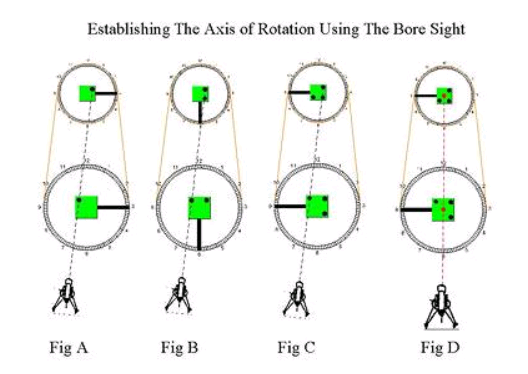
The kiln is then rotated so the fixed ends of the stands are approximately in the 6 o’clock position. Without having adjusted the alignment scope in any way, a second mark is put on each target, Fig B. Again the kiln is rotated to a position where the fixed ends of the stands are now in the 9 o’clock position. Still without any adjustment to the scope a third point is marked on each target, Fig C. Naturally the rough adjustment of the position of the scope must be such that all six points land in the target areas. The accuracy of the results does not depend on the exact amount of rotation.
The similarity with the Direct Method is now evident. Having three points, with simple geometry, defines the center of rotation, Fig E. The two centers of rotation so derived, one on each target,
now define the axis of rotation of the shell, Fig D. As confirmation, an additional rotation to repeat the procedure, can be made.
Given that the sighting scope is mounted with horizontal and vertical adjustment means, it should now be repositioned so that its line of sight is coincident with these two center points. With the instrument so positioned, monuments can then be set at convenient places outside the kiln so that the axis of shell rotation can be re-established at any time thereafter without having to re-introduce targets inside the kiln. This can have a variety of immediate or future uses. This last step is best
accomplished using a total integrated station rather than a simple theodolite. If the external monuments are prisms, conventional re-sectioning and other standard surveying procedures can be used to accurately relocate the instrument in the future. For best results the instrument positionand the reference targets should be well barricaded so that they are never disturbed throughout the course of the kiln work at hand.
Limitations
In using this technique one must be aware of the significant effect of shell flexing and its resulting change of shape with rotation. This is similar to the change of shape of a car tire. It always has a flat spot where it contacts the road, even while underway. The change of shape of the kiln shell is more complex than that of a car tire, it having flat areas at the top, and to a lesser degree, in the vicinity of the rollers. The fixed end of the fixture should therefore not be positioned in those areas during the procedure. For that consideration the clock positions for the target stands as described above are chosen. However, when a tire is known to be abnormally loose on the shell, better
results would be obtained if the upper locations are dropped below the 3 and 9 o’clock positions approaching 4 and 8 o’clock respectively.
When using a visible laser to strike the centerline another apparent limitation is beam divergence. Even with instruments that can focus the laser at set distances, divergence is unacceptable at 100+ meters. Some simple steps can be taken to restore its resolution to about 1 mm diameter even at these distances.
Conclusion
A very precise axis of rotation can be obtained in this way using simple, yet well established techniques, by removing little if any refractory and without any measurements to the kiln’s shell. The axis so established can now be used to position and align a new section of shell without further turning of the kiln.
Although the technique is simple in principle, its successful application is dependent on appropriate fixturing and suitable means for instrument installation / manipulation. None of these are mysterious but are usually not part of a plants normal maintenance facility. The specialist who performs these tasks on a routine basis, who has the fixtures available, is usually the most cost effective choice.
To conclude, as stated at the outset, external alignment procedures, based on finding centers of rotation, are superior to internal methods. This is also true for most cases of shell section replacement work. But when it becomes impractical to turn the shell for alignment trials, the advantages of using bore sight alignment is a formidable alternative.
Kiln alignment and shell ovality: a new approach
Walter M. Gebhart General Manager, Vice-President of International Sales, Phillips Kiln
Service Company Ltd, Sioux City, Iowa, USA.
Introduction
Analysis of kiln alignment and ovality characteristics are important tools which can help to improve or maintain the mechanical stability of a kiln. As cement plants are becoming more maintenance-oriented, the rotary kiln industry has responded with various techniques to determine this information. This report will examine various methods of measuring alignment and ovality and will describe the latest technological developments.
Internal vs. external methods
To overcome this difficulty, both internal and external methods have been developed. However, there are many limitations inherent in both methods. For internal methods to be successful, the kiln must be down. There is often very limited time to take measurements in working conditions that can be very hostile. There is often competition with other activities in and around a kiln during a shutdown period. The kiln must be repositioned at least three times to give some indication of the center of rotation rather than just the geometric center of the shell. An internal
alignment analysis can offer accuracy but the data is not sensitive to the kiln’s operating conditions and can be very expensive to obtain in terms of lost production. In addition, there is no chance for verification of the data until the next shutdown. Traditional external alignment measurement on an operating kiln offers a different set of problems. The heat and motion of the operating kiln can make difficult working conditions even worse. Because the kiln is in motion, more complex data collection procedures are required. Data collected can be inherently less accurate because assumptions must be made as to the creep or tire shell gap. In many cases, inappropriate measurement procedures and instruments may be used if those performing the analysis are inexperienced. Depending on the methods used, reasonable to questionable results can be obtained at a relatively low cost with no downtime. External alignment methods are sensitive to the kiln’s operating conditions and can be verified any time the kiln is operating. Traditional external alignment procedures have various methods of data acquisition ranging from plumb bobs draped over moving tires and piano wire stretched along the roller bases to sophisticated computerized systems and theodolites. All traditional external alignment methods, however, have a common limitation. They all attempt to determine the kiln center based on component geometry (ring and roller diameters, tire/shell gap, and spacing between roller centers) (See Figure 1).
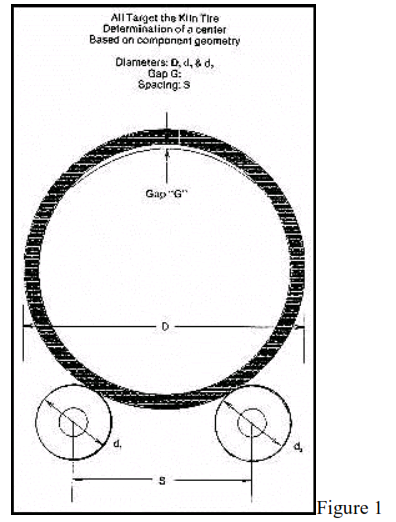
On a moving kiln, it may be very difficult to obtain precise component measurements. Assumptions about the tire/shell gap are often factored into the alignment calculations resulting in potentially inaccurate data. Some external alignment methods use other indirect phenomenon such as ovality as an indication of misalignment. Although ovality curves do show an indication of alignment, it is important to remember that the indication is only qualitative and that damaged shell plate can radically affect the ovality curves as do many other factors. The use of ovality in calculating alignment characteristics is largely a subjective interpretation. Consequently, traditional, internal or external alignment methods present many obstacles including high downtime costs and dubious results. Because of these problems, alignment checks are done infrequently, usually only when kiln damage is evident. The alignment is done after the problem manifests itself rather than as the preventative maintenance tool it could be. Therefore, most kilns
run in less than optimum conditions. Accelerated wear, frequent component failure, and high long- term costs of kiln operation have become accepted norms in some industries.
New alignment technology
A new concept in alignment measurement has emerged which eliminates the major limitation of traditional external alignment methods. This procedure, based on new technology, determines the centers of rotation, independent of component geometry. Using linear measurements from an arbitrarily chosen frame of reference outside the kiln, the true center of rotation of the kiln is determined (see Figure 2).
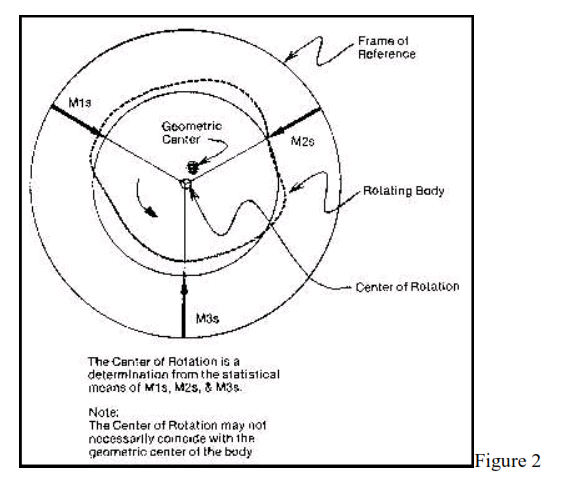
The practical application of this new procedure has many advantages over traditional internal or external alignment methods:
- The final report is presented to and reviewed with plant personnel before the crew leaves the job site.
- The procedure is comparatively simpler, with measurements taken directly on the kiln shell.
- Diameters, surface conditions, gaps and spacing are not factors in determining the kiln alignment.
- There is no limit of applications. Kilns of all types, speeds and processes can be analyzed with
- Measurements are direct functions of the centers of shell rotation (not the geometric centers) and not related to features such as diameters or ovalities.
- Statistical determination of the center of rotation of each support is typically based on over 2000Electronic measurement allows for self checking data, perpendicular measurements (unaffected by thermal conditions of the kiln), and high frequency measurement rates. readings which are logged over the course of numerous revolutions. no downtime. The patented alignment procedure, performed exclusively by Phillips Kiln Services, is successfully completed on over 50 kilns per year.
Ovality
In addition to new alignment technology, a breakthrough has recently been made in kiln shell ovality analysis. Although ovality is sometimes influenced by alignment, it is always of interest and concern with respect to the mechanical stability of refractory. Ovality, as it applies to an operating kiln shell, is the change of curvature or flexing of the shell during the course of each revolution.
The first practical device to actually measure ovality was patented in 1953 by E.R.S. Kareby of Stockholm, Sweden, and was assigned to Skanska, AB, also of Stockholm. In the early 1960s, Holderbank designed improvements for the device and made it commercially available as the THS Shell Test Apparatus. It has been very successful and up to now, the standard of the industry.
There are some practical limitations to the device, however. If not handled properly, its weight can cause it to fall from the shell and damage the delicate mechanical leverage and tracing mechanisms. Proper attachment to the shell to get the best possible tracing is a challenge
especially with larger diameter, fast moving kilns. It is not unusual to reduce the kiln speed to properly place the instrument. The Shell Test Apparatus produces circular chart recordings which resemble the cross section of a kiln shell, creating a visual impression of the degree of ovality. Actual mathematical calculation, however, requires measuring the curves using a simple
draftsman’s scale. Since the diameter of the graph is only 3 in. and the chart is drawn with a pencil, accuracy is compromised. Therefore, the circular graph cannot offer much detail.
Advances in ovality measurement
The first significant improvement in almost 30 years has been made with the development of the High Resolution Ovality Beam (HR Beam). The leverage and tracing mechanisms of the Shell Test Apparatus were replaced with an electronic unit and data logger which opened a whole new world of detail. The difference in the viewing capabilities of the two machines can be comparable to the naked eye versus a microscope. In addition to the enhanced ovality measuring capabilities, the HR Beam is also able to detect other aspects of kiln shell reactions. The HR Beam easily identifies the following shell abnormalities:
- Heavily loaded piers or undersized support components
- Excessive tire/shell gaps
- Bowed shell
- Under-loaded piers
- Misalignment
- Cracked shell
- Damaged or distorted shell plate
As with the original Shell Test Apparatus, great care was exercised to design a High Resolution Beam that would be stable with respect to thermal expansion. The thermally stable design of the new beam has an added advantage. Any thermal effects on the beam are clearly reflected in the data, allowing for computer correction to eliminate the temperature gradient in the data and in the resulting ovality curves. The new beam offers high resolution in a more practical device. The replacement of the mechanical leverage and tracing system with an electronic package has resulted in a much lighter and more compact beam which is much easier to use. The time- consuming adjustments necessary with the Shell Test Apparatus (proper pendulum action, pencil position/pressure/sharpness, etc.) are not required with the HR Beam. To operate the HR Beam, just put it on the shell and push a button to start the electronic readings which will be digitally fed into the data logger. The data logger can hold an entire set of data for a kiln and keep it in subsets according to location. Downloading the data to a computer program then allows data processing and graphing. Optionally, a data logger to process data and send the report and graph to a standard printer is also available. Another departure from the Shell Test Apparatus is the appearance of the ovality graphs. The traditional ovality graphing method was on a circular graph or polar plots. The somewhat superficial appearances of a kiln cross-section can actually hide details and cloud the evaluation. The HR Beam charts the ovality data on an X-Y plot (See figure 3).
- There is no limit of applications. Kilns of all types, speeds and processes can be analyzed with
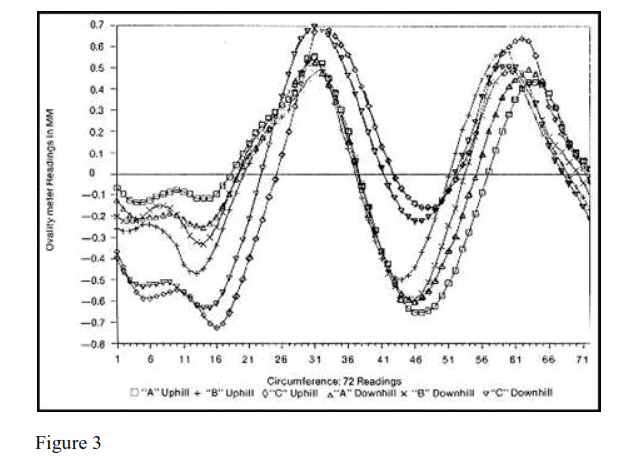
With a circular graph a change in curvature represents a deviation from the circle. In the X-Y plot, a change in curvature is a deviation from a straight line. The eye is much more adept at judging what is a straight line than what is a true circle. In interpreting an HR Beam ovality curve, it is important to understand the concept of kiln ovality. An ideal kiln shell is one that is 100% rigid, does not flex, and would display no ovality. If measured by an HR Beam, the ideal kiln shell would produce a straight line curve. All kiln tires flex, however, to a varying degree. Since the
kiln shell is thinner than the tires, it is similar to a bag of water in a container. There is a tendency for the kiln shell to assume the shape of the tire. As a result, there are three distinct changes of curvature exhibited by a normal and well proportioned kiln shell:
- Because the tire is supported primarily at the bottom, its own weight will cause it to sit flat. This flattening of the tire makes the horizontal axis a little longer than the vertical axis. As a result, the degree of curvature at the 3 and 9 o’clock positions is greater (more positive on the X-Y plot) compared to the 12 and 6 o’clock positions (See Figure 4(a)). 2. Each tire has two point loads where it sits on the two support rollers. The two point loads work to straighten out the tire. As a result, the degree of curvature decreases from the nominal at each roller. This decrease in curvature shows as a negative dip on the X-Y plot (See Figure 4(b)). 3. As the shell flexes inside the tire, a gap forms between the shell and tire at the 12 o’clock position. Here the shell becomes more flat than the tire and another decrease in curvature is recorded as a negative dip on the X-Y plot. Keeping the normal curve pattern in mind, deviations can be easily identified. The stylized curves in Figures 5(a) to 5(f) were taken from actual kiln readings and serve to illustrate the most common types of ovality problems. Although the normal ovality curve is easily identified by shape, it cannot be categorized to an absolute scale. There is, however, an overall ovality range within which curves should fall. This range has been empirically derived over many years and serves as an overall guide for ovality analysis. The considerable spread within that range allows for the fact that all kilns are not created equal nor are the loadings from tire to tire expected to be equal on the same kiln. These detailed aspects of ovality are significant for their qualitative or pictorial value. They serve to highlight and corroborate misalignment and other problems but could be very misleading if not used in conjunction with other data when trying to sort out the many factors affecting them. An example of this is a misaligned roller. The curve would indicate a misalignment but could not by itself be used to determine how much a roller should be moved to gain alignment. To align a kiln to arbitrarily ‘balance’ ovalities pier to pier, (which is nearly impossible with a bowed shell) ignores a host of other considerations and often creates other problems.
Summary
Ovality, or the degree of change of curvature of the kiln shell during rotation, has always been of interest and concern with respect to the mechanical stability of refractory. The Ovality beam, or
‘Shell Test’ rig, continues to be a popular mechanical device used to measure the degree of flexing a shell undergoes during normal operation. With the advent of digital technology, the simple pencil tracings produced by the shell test mechanism have now been replaced by a device which takes digital readings whose graphs reveal the microcosm of changes in shell curvature during rotation. For discerning kiln users who operate large and/or fast moving kilns, particularly the cement industry, the ability of this state-of-the-art ovality beam to spot overloaded piers, excessive tire/shell gaps, a bowed shell, under-loaded piers, misalignment, and even shell cracks, this state- of-the-art ovality beam will be of considerable interest.